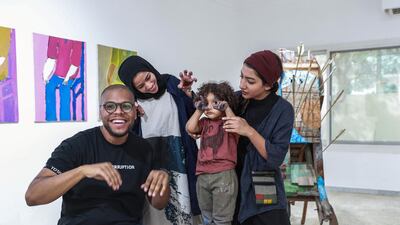“In order for the region and the UAE to elevate its voice to an international realm, you need to focus on what is happening on the ground,” says Abu Dhabi curator Munira Al Sayegh. “What’s going on today is what the coming institution buys tomorrow.”
In a new section at Art Dubai, UAE Now, Al Sayegh has brought together five such art collectives who are working at the grass-roots level in the Emirates. From today until Saturday at Madinat Jumeirah, they will host workshops, performances and exhibitions, bringing their activity to a wider public platform.
The platforms in the UAE Now programme
The UAE Now programme will be anchored by Bait 15’s booth, which fittingly plays home to a number of artists throughout the fair.
Bait 15 is an artists’ run space in the Al Nahyan area of Abu Dhabi. Housed in the former home of the artist Mohammed Al Mazrouei, the artists have studio spaces upstairs and curate exhibitions and events downstairs. One of the five artists who set up the site in 2017, Afra Al Dhaheri, also helped Al Sayegh put together the section for Art Dubai.
As opposed to Bait 15’s physical presence, the other platforms in UAE Now use the internet to reach a cross-regional public. The Banat Collective, run by Sara Bin Safwan, a researcher at the forthcoming Guggenheim Abu Dhabi, explores and supports art made by women in the Arab region via critical writing and consciousness-raising online.
Similarly, Jaffat El Aqlam operates as an online platform for Arab writing, and the Daftar Asfar, a self-described “travelling sketchbook”, commissions artists to make work outside the institution. The fifth collective, Pac (Public Art Collective), researches public art in the UAE.
Why they're so important
The importance of grass-roots and non-institutional platforms, for Al Sayegh, stems from their historical role in setting up the UAE art scene.
In the late 1980s to the early 2000s, contemporary art activity in the Emirates was generated by a group of artists working in Sharjah and later Dubai – Hassan Sharif, Mohammed Al Saadi, MA Ibrahim, Hussain Sharif, and others – who fought against opposition to their work, both from the public and within the established arts scene. It was their then-radical artwork that laid the grounds for the art scene today – a legacy whose importance can be glimpsed in their continuing presence in the art scene.
Galerie Isabelle van den Eynde and Lawrie Shabibi are currently exhibiting solo shows of Hassan Sharif and MA Ibrahim, respectively, and Sharif’s work is also up in “Crude” at the Jameel Arts Centre.
“That conceptual group created the space for us to build up on,” says Al Sayegh. “At that time they were insular – there wasn’t government support. They bounced ideas off one another and were making art that they were compelled by, which they made without a sense of approval from anybody else from the outside.
Al Sayegh sees a similar development of art free from restrictions in the work made by artists from Bait 15, the Banat Collective, and the other platforms that UAE Now hosts and celebrates. “There’s a really interesting divide” among artists, she notes, “and my cause is to create this bridge between the two. There are some government artists who are happy to be moulded and shaped,” she says.
"For example, we need a public art work to celebrate the ocean, so he or she makes a piece in celebration for the ocean. On the other side of that you have artists who, thanks to the Seaf programme and its likes, start to come out and are thinking for themselves, and want to create a real through-line and a clear message in their work."
Investing for the future
The Seaf programme is the 10-month postgraduate study project run by the Sheikha Salama bint Hamdan Foundation in Abu Dhabi. It is working in partnership with the art school RISD in the US, and over its six years, has nurtured some of the most talented artists in the UAE. The programme's emphasis on a critical approach to the making of art is reflected in UAE Now's collectives, as in the work of Al Dhaheri, Maitha Abdalla, and Hashel Al Lamki at Bait 15, all of whom are Seaf graduates.
UAE Now will provide a space for the disparate networks to broaden their informal networks of exchange, despite their relatively low public visibility. The section gives Art Dubai visitors a chance to glimpse what is happening on the ground with young Emirati and long-term resident artists.
Al Sayegh previews the themes that she sees happening around her: “There’s definitely a response to transformation and the direct effect it has on identity,” she says. “The identity of self outside of what society dictates as being an Emirati – Emirati or someone who lives in the UAE and contributes to society. How does one exist within a society that is rapidly changing, but that also stays the same because of tradition?
“And how can one question tradition, in order for it too to transform in a way that is respected by both parties, those who want to hold on to it in the way that it is already, and those who want to move with it?”
UAE Now takes place in the Mina A’Salam building (the former site of Art Dubai Modern) in Madinat Jumeirah, with programming daily at 1pm, 3pm, 4.30pm, from today until Saturday


